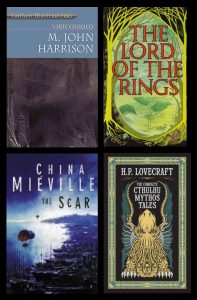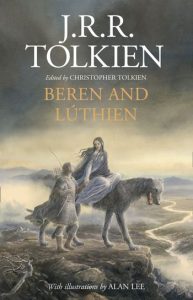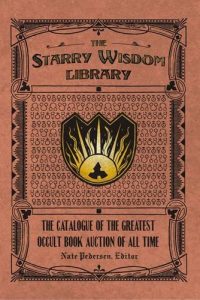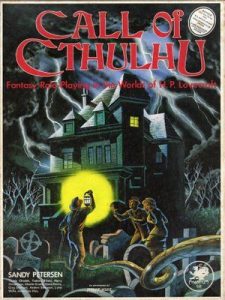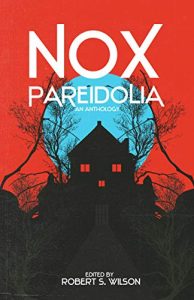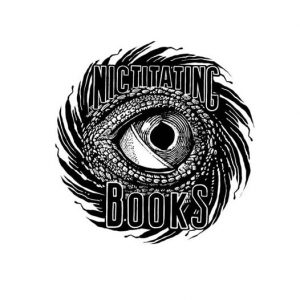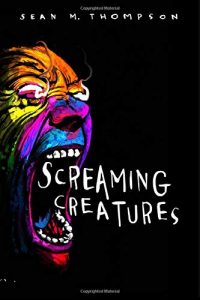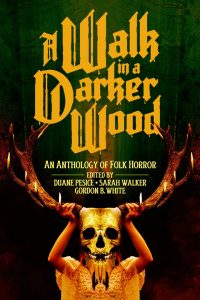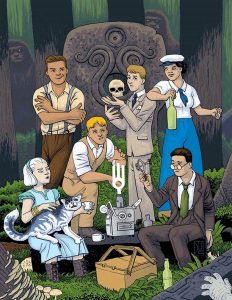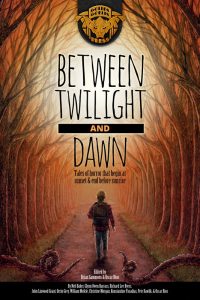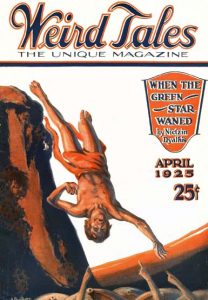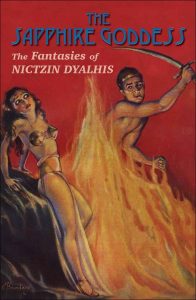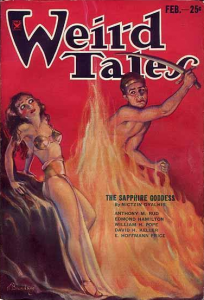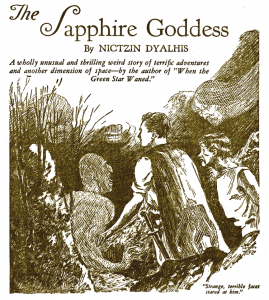Today – Tolkien, Lovecraft, Mieville and M John Harrison! Welcome, dear listener, to this week’s exclusive mega-article, in which one of our regular guest columnists, Paul StJohn Mackintosh, has a serious ponder on the question of worldbuilding in fantasy and weird fiction.
“Above all, worldbuilding is not technically necessary. It is the great clomping foot of nerdism. It is the attempt to exhaustively survey a place that isn’t there. A good writer would never try to do that, even with a place that is there…” M John Harrison
We do hope you find this essay thought-provoking – we did – and remind you that if you enjoy it, you are tuned to the eclectic greydogtales. If you do not enjoy the piece, then we have never heard of Paul StJohn Mackintosh, and have no idea how he got here.
NOTE: Those readers in a rush (tut-tut) will find detail on Tolkien and worldbuilding in Section Two further below, and detail on Lovecraft in Sections Three to Five. But you’ll miss some of the key points of the argument, so…
LOVECRAFT THE UN-NERDIST: ON WORLDBUILDING AND SHARED WORLDS
by Paul StJohn Mackintosh
Introduction
This article is inspired mostly by M. John Harrison’s intensely stimulating (as always) reflections on world building, and his cautions against “the great clomping foot of nerdism.” Nowadays, H.P. Lovecraft is jostling John Ronald Reuel Tolkien from top slot as the paradigmatic writer for nerdism. Lovecraft, after all, owes a huge slice of his modern celebrity to a roleplaying game, to a degree that some of his proponents still haven’t fully understood or appreciated. Lovecraftian references are still more cliquely, in-jokey, nerdy, than Sean Bean memes about not just simply walking into Mordor.
Those Tolkien references are worth making, though, because Tolkien remains the pioneering instance of worldbuilding at its most uncompromising, and a key standard of comparison when other writers such as Lovecraft are being assessed on the same criteria. China Miéville wrote in his Amazon Book Review essay “There and Back Again: Five Reasons Tolkien Rocks”: “Every few years, certain as tides, someone will write a splenetic screed against the Professor, explaining why he’s the devil/ worst things to happen to fantasy/voice of reaction/zomg most boring writer EVER /etc.” However, he adds, “the Oedipal Resentment motivating many of these attacks may be trivially obvious, especially in those from within fantastic fiction, but it doesn’t follow that the substance of all the criticism is baseless.”
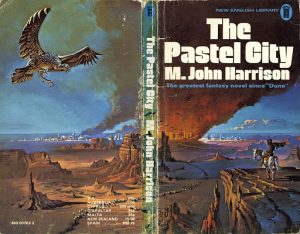
In the same article, Miéville references “the ferocious attack by M. John Harrison, that outstanding anti-fantasist,” on worldbuilding, conceding “that it’s hard to insist that it brings aesthetic and epistemological possibilities to the table that may be valuable and impossible any other way. This is a debate that needs to be had.” Fine, let’s have it. Yet we also need to clarify that we’re actually debating the same thing, because I happen to believe that there’s a couple of different issues in play here, and Harrison’s characteristically gnomic assertions don’t necessarily help to differentiate them. Primarily, I want to discuss whether nerdish worldbuilding is as pernicious as Harrison maintains, and whether Lovecraft really is an instance of it; and secondarily, pick up various other issues around worldbuilding and imaginative fiction along the way.
(In these days of Black Lives Matter, it’s worth mentioning that this essay does not directly deal with Lovecraft’s dismal record on racial and other matters – although it certainly doesn’t ignore or excuse same. Letting Lovecraft off the hook as a worldbuilder in Harrison’s terms doesn’t remotely let him off the hook as a racist, a far-right nihilist on the Hamsun/Celine pattern, and a fellow-traveller of fascism. But it might help to look at the symptoms of those ideological syndromes, and to decide how much worldbuilding is actually implicated in them, and vice versa. And “problematic” areas of worldbuilding, such as “the maggot-folk of Mordor,” are definitely on the agenda.)
This is also an examination of my own reactions to Lovecraftian fiction. Like any nerd, I start to get wet at the slightest name-dropping of a Mythos canon denizen or tome. Why is that? Why does the merest hint of a Lovecraftian trope, an ogg or an oth, which may be only a single allusive sentence in an entire short story, set me off in the way that a plain vanilla tale wouldn’t? Is this just some form of nerd triggering? Or is something else going on?
ONE: Writing against worldbuilding
“When I use the term ‘worldbuilding fiction’ I refer to immersive fiction, in any medium, in which an attempt is made to rationalise the fiction by exhaustive grounding.” M John Harrison
To start with, let’s consider Harrison’s beef with worldbuilding, because it’s a pretty intransigent one. “Every moment of a science fiction story must represent the triumph of writing over worldbuilding.” He’s that forthright. Never one to duck a good fight, he continues: “Worldbuilding literalises the urge to invent. Worldbuilding gives an unnecessary permission for acts of writing (indeed, for acts of reading). Worldbuilding numbs the reader’s ability to fulfil their part of the bargain, because it believes that it has to do everything around here if anything is going to get done. Above all, worldbuilding is not technically necessary. It is the great clomping foot of nerdism. It is the attempt to exhaustively survey a place that isn’t there. A good writer would never try to do that, even with a place that is there… This gives us a clue to the psychological type of the worldbuilder & the worldbuilder’s victim, & makes us very afraid.”
So what is worldbuilding fiction on these terms and how is it done? According to Harrison, “When I use the term ‘worldbuilding fiction’ I refer to immersive fiction, in any medium, in which an attempt is made to rationalise the fiction by exhaustive grounding, or by making it ‘logical in its own terms’, so that it becomes less an act of imagination than the literalisation of one. Representational techniques are used to validate the invention, with the idea of providing a secondary creation for the reader to ‘inhabit’; but also, in a sense, as an excuse or alibi for the act of making things up, as if to legitimise an otherwise questionable activity.” That term “secondary creation” is a key one for Tolkien, and we’ll pick it up later. Critically, Harrison also acknowledges that: “something describable as worldbuilding goes on in the representational genres, and in even the most minimal of ‘mundane’ fictions… I see no technical distinction between the worldbuilding of the representational writer – the travel writer or memoirist – & the worldbuilding of the fantasist.”
Readers shouldn’t need me to remind them that there is no fundamental difference at all between Jonathan Franzen describing his American households in The Corrections, and Iain M. Banks describing the nattering AIs and agents of the Culture in Consider Phlebas. They’re both equally lies; they’re both equally made-up. The kind of critic who claims that the first is more real, more true to life than the second tends, a) to deserve all the criticism they usually get in response for being deeply normative, presumptive, and even oppressive; and b) to be deeply confused about the nature of truly representational writing that really tries to describe what’s going on. Good journalistic writing which really describes things well is usually worlds away from a systematic, objective, photorealistic representation of the situation observed. Franzen’s writing actually might be more interesting if he wrote like a good journalist – Hunter S. Thompson, perhaps?
However, things come seriously unstuck in the application of worldbuilding to genre fiction, Harrison continues. “There was always a game being played, between writers and readers… Worldbuilding is the province of people who, like Tolkien, actually resist the idea it’s a game, and have installed their ‘secondary creation’ concept as an aggressive defense of that position… The worst mistake a contemporary f/sf writer can make is to withhold or disrupt suspension of disbelief. The reader, it’s assumed, wants to receive the events in the text as seamless & the text as unperformed. The claim is that nobody is being ‘told a story’ here.”
Harrison advances many other very persuasive reasons as to why this is a bad, as well as simply an unnecessary, thing. “It’s control-freakery on a scale that reminds you instantly of the other kind of worldbuilding – the political kind. That’s why I am ‘very afraid’ of worldbuilders. They tend to be quite managing, even in real life.” I don’t necessarily agree on that score, as far as it goes. To take one example, N.K. Jemisin is a huge proponent of worldbuilding, and offers regular masterclasses on the subject. Would Harrison class Jemisin as someone we need to be afraid of for her worldbuilding? Does The Broken Earth trilogy deserve that kind of warning? Or is worldbuilding only a Bad Thing in the hands of a right-wing writer – and if so, would Lovecraft qualify?
I do side with Harrison against worldbuilding on other grounds, though; but they’re more aesthetic and literary than ideological. I just don’t think that lists and lexicons make good literature. Mozart may have been able to set a laundry list to music, but I doubt many other writers would be well advised to try. Yet they go on doing it, from various motives – in Tolkien’s case, very weird ones. And a writer who’s writing lists is obviously not spending time writing literature and is not content with literature. Note that by literature here I mean not some high-culture Franzenesque canon, but just interesting and well-wrought prose.
For some writers and readers, the worldbuilding error is a child of the 19th century, and a symptom of the abdication of the arts and humanities before the hollow prestige of scientism. It’s analogous to the famous anecdote of James McNeill Whistler creeping up behind the Ruskinian topographical painter John Wharlton Bunney, busily, obsessively, painting every detail of the facade of St Mark’s in Venice, and sticking a label on his back stating “I am totally blind.”

It’s analogous also to John Ruskin’s attack on Whistler “for flinging a pot of paint in the public’s face,” and the latter’s court defence of “the work of a lifetime” in the ensuing libel trial. Ruskin had convinced himself that art was only valid (“good”) if it exhibited intensive labour; Whistler had demonstrated (ironically, just like Ruskin’s idol Turner) that art could trigger the imagination, create a world, with just a few strokes of paint dashed off in a day.
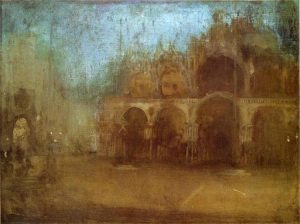
To show what I mean in a more modern, speculative context, here’s a brilliantly evocative piece of fantastic description that absolutely refuses worldbuilding, a passage from Light, by M. John Harrison, no less:
Alarms chimed. The shadow operators flew about. The White Cat went up to full readiness. Her battle clocks, reset to zero, began to count off in femtoseconds, the last stop before the unknowable realtime of the universe. Meanwhile, she diverted fusion product into engines and ordnance and began, as a precautionary spoiling measure, to flicker in and out of the dynaflow at random. From this behaviour, Seria Mau judged they were in an emergency.
“What?” she demanded of the mathematics.
“Look,” it recommended, and began increasing the connections between her and the White Cat until, in important ways, Seria Mau became the ship. She was on ship time. She had ship consciousness. Processing rates ramped up by several orders of magnitude from the paltry human forty bits a second. Her sensorium, analogued to represent fourteen dimensions, echoed with replicas of itself like a cathedral built in ‘brane-space. Seria Mau was now alive in a way, in a place – and at a speed – which would burn her out if it lasted for more than a minute and half. As a precautionary measure the mathematics was already sluicing the tank proteome with endorphins, adrenalin inhibitors and warm-down hormones which, operating at biological speeds, would take effect only after any encounter was finished.
“I was wrong,” it said. “Do you see? There?”
“I see,” said Seria Mau. “I see the fuckers!”
You’d be hard put to find a juicier, more exciting episode of combat on a page in Tom Clancy or Patrick O’Brian, let alone Tolkien, whose descriptions of hand-to-hand fighting always struck me as peculiarly abstract and bloodless for a writer who had seen real war up close. Now, does any reader seriously think that Harrison exhaustively diagrammed and worked out the capabilities of the White Cat like a Star Wars fandom wiki entry? Does anyone seriously believe that the fourteen-dimensional femtosecond-calibrated battle space of this excerpt is physically, mathematically consistent? Does anyone imagine that this mishmash of cosmological, perceptual, and physiological jargon and technobabble is reducible to some underlying systematic and self-consistent preconceived structure and theory? I hope not, because that surely isn’t the author’s intention. Harrison only steals from the best, but his poachings of physicists’ patois aren’t there to do anything more than hint at scientific rigour: they’re there because of their power to stimulate the imagination, not to articulate some unified theory. They don’t describe; they evoke. And they’re surely more effective, more evocative, because they don’t even try to be representative. And trust me: Light does not have a list at the back of it.
I hope this shows what I think is wrong with exhaustive, prosaic, pedantic worldbuilding. The more you overstuff the reader’s imagination with pap to feed off, the more you betray your lack of faith in the imagination itself. And you certainly weigh it down too much to fly. Acts of the imagination may work best not with more information, material to go on, but less – because then the audience’s imagination is engaged to fill in the blanks and round out the spaces begging to be filled with their own acts of participatory imaginative creation. As Harrison says, “much of what appears to be the work of writing is in fact done by the reader in the act of reading.” Audience participation is almost always a winner in the performing arts: why deny it on the printed page? Too much information swamps it. But for a reader, or an author, to hope that, and act as if, your imaginary fictional world is literally [sic.] real is paradoxically the worst disrespect you can do to a work of art, because that absolutely undermines the very premise and validity of its creation. The flakes who want to believe that the Necronomicon is real don’t do Lovecraft any favours.
You can see the commercial imperative for this kind of overbuilding: the more fabrication of systematic worldbuilding tropes goes on, the more props and pops and figurines and t-shirts can be sold.
The typical writer who worldbuilds to validate their world, in Harrison’s sense, to go beyond literary prose to the enumeration of fake fact, performs an act of bad faith in the classic existentialist sense of self-deception. They pretend to believe in and valorize the imagination and the world it creates, while demonstrating with every move that they don’t place any value in the works and processes of the imagination, and believe that those need all the props and mechanisms borrowed from the procedures of the physical sciences to prop them up and stop them deflating. They can’t suspend disbelief without a panoply of pseudo-rationalism. You can see the commercial imperative for this kind of overbuilding: the more fabrication of systematic worldbuilding tropes goes on, the more props and pops and figurines and t-shirts can be sold. There’s also the possibility that a bad piece of speculative creativity, with no power to spark the imagination or capture the emotions, can be redeemed or compensated for by a raft of merch (the later Star Wars movies, anyone?).
TWO: Tolkien it out
Obviously, I’m qualifying Harrison’s blanket condemnation of worldbuilding at this point. That’s mainly because there’s some divergences in the bases for worldbuilding that deserve looking at. (I’m still with Harrison on its anti-literary aspects.) The paradigmatic exemplar of world-building, Tolkien, was anything but a materialist with a bad conscience about fantasy. Instead, as his 1947 essay “On Fairy-Tales” makes abundantly clear, he actually believed, or professed to believe, that myth and fantasy are potential conduits to the ultimate primal reality hidden under the illusion of this fallen world. In other words, that the secondary creation of the fantasist is a more faithful reflection of God’s Creation than the world we live in. To me at least, that way of thinking deserves all the hostility that Harrison heaps on it. A True Believer could wreak all kinds of damage on the world in its name.
Tolkien does in fact manifest a surprising amount of aggression and hostility in his essay. You can understand someone who went through the mechanised slaughter of WWI developing a profound antipathy towards industrial civilization, but I doubt that the denizens of Hogarth’s slums had a much better or more attractive time living in an agricultural one. But no, for Tolkien all evil and ugliness has to begin with the Industrial Revolution. “Why should we not escape from or condemn the ‘grim Assyrian’ absurdity of top-hats, or the Morlockian horror of factories?” That kind of visceral hatred is an all too common phenomenon in conservative England: the Old Rectory syndrome militant. “The notion that motor-cars are more ‘alive’ than, say, centaurs or dragons is curious; that they are more ‘real’ than, say, horses is pathetically absurd.” And Tolkien’s weapon of choice against the modern world was worldbuilding: obsessive fabrication of a mythical reality, which thanks to his bizarre pseudo-Catholic epistemology, he believed held more truth than the made world. “It is not difficult to imagine the peculiar excitement and joy that one would feel, if any specially beautiful fairy-story were found to be ‘primarily’ true, its narrative to be history, withoutthereby necessarily losing the mythical or allegorical significance that it had possessed… such joy has the very taste of primary truth.”
The result, his so-called Legendarium, was anything but joyous: it’s predominantly as dull and unliterary as anything by his successors. It’s almost as much of a colossal abortion as another exercise in metaphysical worldbuilding: Hegel’s philosophy. Yes, everyone reads The Hobbit and toils through The Lord of the Rings with occasional longueurs. How many people read The Book of Lost Tales or The Fall of Gondolin or the 12-volume History of Middle-Earth? There is absolutely no reason why all those volumes should not have been as readable and enjoyable and fun as The Hobbit, or as any of Walter Scott’s vast oeuvre of historical novels – should have been good fiction. But they’re not. They’re massive exercises in worldbuilding which left literature far behind and as a result almost nobody reads them. Maybe Tolkien felt from his own point of view that the dose of Prime Reality in them gave them equal stature to The Lord of the Rings and other masterpieces of imaginative fiction. I beg to differ.
Tolkien himself speculated, in “On Fairy-Stories,” on “the nature of Faërie: the Perilous Realm itself, and the air that blows in that country. I will not attempt to define that, nor to describe it directly. It cannot be done. Faërie cannot be caught in a net of words; for it is one of its qualities to be indescribable, though not imperceptible.” Yet leaden nets are exactly what he and many of his self-styled devotees and successors appear to use when attempting to capture the essence of enchantment.
THREE: Lovecraft beyond worldbuilding
As the Walter Scott parallel should make clear, Tolkien didn’t have to go that way. There are artistic possibilities even in worldbuilding that have hardly been explored. If you’re going to produce a fake itinerary for an imagined place, why not write it like Italo Calvino’s Invisible Cities? If you’re going to produce a vocabulary for a fake language, why not write it like Ambrose Bierce’s Devil’s Dictionary? And if you’re going to produce a longlist of imaginary grimoires and Tomes of Power, why not produce a compilation like the brilliant The Starry Wisdom Library? Again, the reason is probably that, once again, any literary jeu d’esprit, any playful and imaginative spin on the original content draws unwelcome attention to the fact that the original isn’t “real.” On the other hand, for anyone except a deeply committed insider, there can be nothing more tedious, nothing more dull and pleasure-destroying, than the endless pedantic mind-numbing literal enumeration of imaginary places in a fantasy gazetteer.
Needless to say, Lovecraft isn’t like that. Almost all of his work, however uneven, does get read, and there’s no 12-volume History of the Mythos dragging along in their wake – unless you count Lovecraft’s voluminous letters. Lovecraft the determinedly nihilistic scientific realist may have exercised his own inclinations to worldbuilding in his Dream Cycle, but he didn’t persist in that vein, and certainly didn’t do much systematic list-building about it. More importantly, Lovecraft’s declared premises, practice and aesthetic are completely pointed in the opposite direction. He doesn’t seem especially concerned with substantiating or justifying an imaginary fantasy world in contrast to the real one. His “Notes on Writing Weird Fiction” begins with “My reason for writing stories is to give myself the satisfaction of visualising more clearly and detailedly and stably the vague, elusive, fragmentary impressions of wonder, beauty, and adventurous expectancy which are conveyed to me by certain sights (scenic, architectural, atmospheric, etc.), ideas, occurrences, and images encountered in art and literature.”
That aesthetic and approach sounds much closer to Whistler than Tolkien. Lovecraft’s “actual process of writing” described in the same essay doesn’t make a single nod towards worldbuilding, though it does towards straightforward craftsmanship and careful writing. His “four distinct types of weird story” also don’t refer to any great design of fabricating an imagined alternative fantasy world. To quote S.T. Joshi, “Lovecraft’s imaginary cosmogony was never a static system but rather a sort of aesthetic construct that remained ever adaptable to its creator’s developing personality and altering interests.” Tolkien wrote entire encyclopaedias devoted to his imaginary world; Lovecraft dismissed his as Yog-Sothothery.
Look at Lovecraft’s analysis of his idol, Edgar Allan Poe, from ‘Supernatural Horror in Literature’:
Poe… perceived the essential impersonality of the real artist; and knew that the function of creative fiction is merely to express and interpret events and sensations as they are… Poe’s spectres thus acquired a convincing malignity possessed by none of their predecessors, and established a new standard of realism in the annals of literary horror. The impersonal and artistic intent, moreover, was aided by a scientific attitude not often found before; whereby Poe studied the human mind rather than the usages of Gothic fiction, and worked with an analytical knowledge of terror’s true sources which doubled the force of his narrative.
Again, millions for Art, but not one cent for Unreality.
Lovecraft’s writing at his most fantastic, most imaginative, also demonstrates just how far he is from the worldbuilding approach. When he pretends to describe an indescribable unnamable thing, he’s actually doing the complete opposite to systematic enumeration: usually he’s lumping together a whole mess of contradictory and incompatible qualities that make as much overt sense as soluble fish. That’s the absolute opposite of the worldbuilder’s literalist instinct, or just doesn’t describe anything at all and leaves it resonantly suggestive with no indication of how or what it actually is. Did Lovecraft ever actually say what Shub-Niggurath the Black Goat of the Woods with a Thousand Young looks like? Or even what it is? Needless to say worldbuilders and secondary writers have jumped in to fill the gap he wisely left open.
In his superb introduction to Lovecraftian roleplaying in the Swinging Sixties, The Fall of DELTA GREEN, veteran RPG designer Kenneth Hite describes how to non-describe menaces and threats from the Cthulhu Mythos, based on Lovecraft’s own procedures:
“When it comes time to present your new-fledged horror, there’s no better approach than Lovecraft’s. He described such things using two techniques, which we might term catachresis and cubism. Catachresis is a poetic technique in which a deliberate misuse of language or impossible metaphor inspires a response: a solid creature ‘filters’ or ‘seeps,’ a god resembles a ‘shining darkness,’ and so on. Here is where Lovecraft gets his angles that are ‘both acute and obtuse,’ his elements unknown to science, and the ‘indescribable’ in general… To catachresis, Lovecraft adds cubism: drowning the image in details, often invoking other images until the result is just as impossible as the acute-obtuse angles on R’lyeh. Cthulhu resembles ‘simultaneous pictures of an octopus, a dragon, and a human caricature.’ The dissected Elder Things and the disintegrating Wilbur Whateley have so many ‘surfaces’ – scales, barrels, tendrils, wings, tentacles – to examine that they become completely fluid and chaotic.”
If such things are beyond literal description, what chance does the worldbuilder have to systematically represent and categorize them? Yet many try, over and over again.
FOUR: Ludic literature and Lovecraft
As well as a dedicated, if uneven, devotee of literature as an art form rather than a channel for a Secondary Creation, Lovecraft was a literary game-player to rival any of the 18th-century writers he emulated. Put aside for one moment the Pass-the-Pnakotus games of swapping tropes and inventions that he played with Robert E. Howard, Clark Ashton Smith and the rest of his extensive coterie of correspondents and co-authors, and look at the jests in some of his best stories. Do dedicated Lovecraft readers wince and hurry on by when they read the reference to “the Atlantean high-priest Klarkash-Ton” in The Whisperer in Darkness? Do they flinch fastidiously when they note that the protagonist of ‘The Haunter of the Dark’ is named Robert Blake after Robert Bloch? Those kind of fourth-wall-breaks definitely militate against Harrison’s tongue-in-cheek warning for the genre writer that: “any vestige of performativeness in the text dilutes the experience by reminding the reader that the ‘world’ on offer is a rhetorical construct. All writing is a shell game, a sham: but genre writing mustn’t ever look as if it is.”
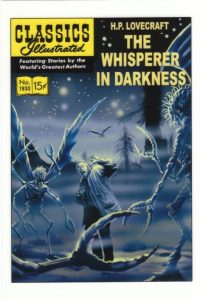
Games, literary or otherwise, are an area where Lovecraft might be lumped into the worldbuilding camp. In his 2001 essay “ What It Might Be Like to Live in Viriconium,” Harrison touches on “the relationship between fantasy and games – medieval re-enactment societies, role-play, and computer games. Games are centred on control. ‘Re-enactment’ is essentially revision, which is essentially reassertion of control, or domestication.” But in his later notes on worldbuilding he also emphasizes the ludic nature of literature as “a game being played, between writers and readers… who knew they were gaming a system, & who were delighted to engage each other on those terms.”
Maybe games can be good in one context and bad in the other, but I’d rather leave things a little more open than that. It does strike me that games and especially role-playing games do furnish the kind of world that Miéville talks about in his analysis of Tolkien in his 2005 essay “With One Bound We are Free: Pulp, Fantasy and Revolution,” and takes up again in his Amazon Book Review, an imagined world that exists prior to and superior to any story unfolding within it: “His genius lay in his neurotic, self-contained, paranoid creation of a secondary world. That act of profoundly radical geekery reversed the hitherto-existing fantasy subcreation: unlike Eddison’s Mercury and Leiber’s Newhon, Middle Earth comes before the stories that occur within it.” The point, which perhaps gets gaming off the worldbuilding control-freak hook that Harrison skewers it on, is that game worlds are no longer the creation or property of a single authorial authority: by necessity and by design, they become a communal property.
A shared-world community isn’t necessarily a good community; some game worlds can have pernicious qualities. Look at the furore now surrounding Wizards of the Coast and the perpetuation of the traditional topos of Dungeons and Dragons, where players grow endlessly more powerful by killing things, especially the intelligent species deliberately given unattractive racial characteristics and tagged as Evil just so that players can grow more powerful by killing them. But that is not an inherent consequence of the nature of the game as a game, and you can change the inclinations that the game world facilitates by changing its rules, just as you can change the world-view that a work of fiction promotes. Look at how some Lovecraftian game worlds have gone in a completely opposite direction to Lovecraft’s own racist ideas, and used the tools of game design and game world creation against them – just like some Lovecraftian fiction writers have.
Look how the dictatorial authority of the author that Harrison rails against in worldbuilding is being chipped away by fanfiction, wikis, expanded universes, communities, and all the other movements that are acting to emancipate creations from their creator and make them shared public (domain?) property. The readers are essentially acting on their part of the bargain, and demanding their share of the imaginative contract with authors. Gamesplaying and the roleplaying community absolutely demonstrates how this happens. Shared worlds are no longer temples where readers pay admission to bow down and receive the Word from on High: they’re amusement parks where the audience creates the props and manages the rides.
As for the controlling aspect of rules, it’s worth highlighting the broad split in the modern RPG community between two approaches frequently tagged as Simulationist versus Narrativist. The Simulationist gamers, historically dominant in the early days of the hobby, dreamed up long lists of rules, tables, races and monster types, and other reams of extremely crunchy detail, to try to do what what the physics model does in a video game, and exhaustively simulate an imagined world through mathematical mechanics. The Narrativist approach, on the other hand, tends to work with very lean and adaptable rule systems; in the words of Fate system guru Robert Hanz, “‘Fiction First’ is the Golden Rule of Fate.” Narrativist RPG design and play explicitly recognises and accepts that the gamemaster and players are engaged in an exercise of collaborative storytelling, and attempts to facilitate and stimulate that, rather than devalue the fun of fiction in an attempt to simulate reality. (No prizes for guessing which approach is more geekish, and which one I favour.)
FIVE: Living & Lovecraft, Ludism & Literature
Almost all built worlds are shared worlds now – and any ambitious fantasy or speculative fiction author will surely hope against hope that theirs will become one too, as the high road to popularity and marketing bucks.
Once again, living inside or outside a fantasy world is no guarantee of good or decent behaviour either way. Fiction is play, gaming is play, but the kind of immature personality that wants to bring the ethics of the playground to adult life tends to create a real problem for the real world. Yet the fake world and fake news of Fox News has undoubtedly done more harm than any number of escapist fictions or shared fantasy worlds of the genre fiction kind. I don’t regard the latter as bad in themselves. They are certainly places where bad things can be said and supported, but anyone who has a problem with that is best advised to go engage with them on their own terms and do it better.
Almost all built worlds are shared worlds now – and any ambitious fantasy or speculative fiction author will surely hope against hope that theirs will become one too, as the high road to popularity and marketing bucks. Control-freakish attempts to continue to dictate and define the terms of those worlds may happen – but for an indicator of how successful those are likely to be, look at the trans community’s fan-fiction pushback against J.K. Rowling’s statements. If she can’t cling onto control, who can? As said, that doesn’t mean those shared worlds will necessarily be built on any values that anyone else would want to share – look at the Gor subculture, with its misogynistic fantasy gender traditionalism and its extensive fanfic literature. That also doesn’t mean that fantasy writers who avoid worldbuilding will ipso facto embrace ideals we can share: Lovecraft himself is a less-than-shining example. But the debate about worldbuilding is more worth having in a different context: that of Art and Imagination versus Mechanics and Information.
Maybe we need a lot less than we think to project us into an imagined shared world. Maybe just an ogg or an oth is enough, maybe just one of Whistler’s brush strokes. Rather than listen to the deadening drone of some long list of non-existent places in a non-existent place, I’d prefer to listen out for the whippoorwills in the hills or the buzzing insect voices of the Mi-Go any day.
Paul StJohn Mackintosh, July 2020
Paul StJohn Mackintosh is a Scottish poet, writer of weird fiction, and translator. Born in 1961, he was educated at Trinity College, Cambridge, has lived and worked in Asia and Central Europe, and currently divides his time between Hungary and other locations.
You may also be interested in John Coulthart’s excellent long article on Harrison’s Viriconium and the many attempts to reflect its contents on the covers of published editions.
“In the fourteen years that Harrison worked on his series he used its mutable qualities to pull the entire project to pieces without actually destroying it or turning the whole thing into a self-regarding postmodern game. The early books critique the lazy assumptions of the fantasy genre while the later books recast the earlier stories as myths or half-remembered dreams.”
{ feuilleton } A journal by artist and designer John Coulthart.
http://www.johncoulthart.com/feuilleton/2012/06/11/covering-viriconium/
